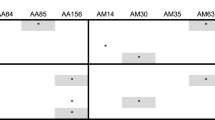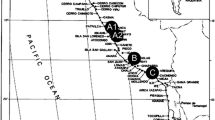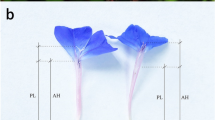Abstract
Incompatibility reactions of 21 varieties of summer, autumn and winter type cauli-flowers were assessed by
-
(a)
comparing the seed sets per siliqua from separate inflorescences of the same plant which were self-pollinated and mixed-pollinated with self and Brussels sprout pollen,
-
(b)
correlating the percentage hybrids from the mixed-pollinations with those from natural cross-pollination,
-
(c)
differentiating between the self- and mixed-pollinations by the proportions of seed set in each quarter of the siliquas, and
-
(d)
calculating the percentage of hybrid seed in each quarter of the siliquas following mixed-pollination.
All three cauliflower types set similar amounts of seed upon artificial self-pollination, but the autumn and winter cauliflowers exhibited a "facultative self-incompatibility" by their ability to set more seed following mixed-pollination with self and Brussels sprout pollen. The percentage of hybrids in the progenies from the mixedpollinations were—summer cauliflowers 18.2, autumn cauliflowers 57.1, and winter cauliflowers 71.9. These results were similar to those found after natural cross-pollination.
Calculations of the percentage of hybrid seeds in each quarter of the siliqua showed that the ratio of hybrid: self seeds was the same in all quarters of the siliqua, indicating that restrictions of pollen tube growth in these cauliflower types is confined to the stigmatic surface.
It is suggested that the annual type summer cauliflowers were derived from biennial types by constant selection of a small number of plants for uniformity and quality which has led to self-compatibility as a correlated response. It is also suggested that under similar intense selection self-compatibility may possibly be attained in the autumn and winter types.
Similar content being viewed by others
References
Balls, (1919). The cotton plant in Egypt. Macmillan. London.
Bateman, A. J. (1955). Self-incompatibility systems in Angiosperms III. Cruciferae. Heredity 9: 53–68.
Bateman, A. J. (1956). Cryptic self-incompatibility in the wallflower: Cheiranthus cheiri L. Heredity 10: 257–261.
Crane, M. B. (1943). The origin and relationship of the Brassica crops. J. R. hort. Soc. 68: 172–174.
Crosby, J. L. (1954). Population and evolution-The significance of incompatibility. Proc. 8th Int. Bot. Congr., 163–169.
Drayner, J. M. (1959). Self and cross-fertility in field beans (Vicia faba L.) J. Agri. Sci. 53: 387–403.
Jensma, J. R. (1957). Teelt en veredeling van bloemkool. Meded. 96. Inst. Vered. Tuinb. gewassen.
Jones, D. F. (1922). Selective fertilisation and the rate of pollentube growth. Biol. Bull. 42: 167–174.
Kakizaki, Y. (1930): Studies on the genetics and physiology of self-and cross-incompatibility in the common cabbage (Brassica oleracea L. var. capitata L.). Jap. J. Bot. 5: 133–208.
Kearney, T. H. and Harrison, G. J. (1924). Selective fertilisation in Cotton. J. Agric. Res. 27: 329–340.
Kirchner, O. (1905). Über die Wirkung der Selbstbestäubung bei den Papilionaceen. Naturw. Z Land-Forstov. 3: 97.
Lamm, R., Hintze, S. and Avall, H. (1957). Klassificerande sort-och stamförsök med köksväxter. Med. 110. Tradgardsform Alnarp.
Lewis, D. (1951). Structure of the incompatibility gene. III. Types of spontaneous and induced mutation. Heredity 5: 399–414.
Mather, K. (1943). Specific differences in Petunia. I. Incompatibility. J. Genet. 45: 215–235.
Mather, K. and de Winton, D. (1941). Adaptation and counter-adaptation of the breeding system in Primula. Ann. Bot. Lond. N.S. 5: 297–311.
Sampson, D. R. (1957). The genetics of self-and cross-incompatibility in Brassica oleracea. Genetics 42 (3): 253–263.
Sears, E. R. (1937). Cytological phenomena connected with self-sterility in the flowering plants. Genetics 22: 130–181.
Stebbins, G. L. (1957). Self-fertilization and population variability in the higher plants. Amer. Nat. 91: 337–354.
Verkerk, K. (1954). The influence of low temperature on flower initiation and stem elongation in Brussels sprouts. Koninkl. Nederl. Akademie van Wetenschappen-Amsterdam.
Williams, W. (1951). Genetics of incompatibility in alsike clover. Trifolium hybridum. Heredity 5: 51–73.
Author information
Authors and Affiliations
Rights and permissions
About this article
Cite this article
Watts, L.E. Investigations into the breeding system of cauliflower Brassica oleracea var. botrytis (L.). Euphytica 12, 323–340 (1963). https://doi.org/10.1007/BF00027468
Received:
Issue Date:
DOI: https://doi.org/10.1007/BF00027468




